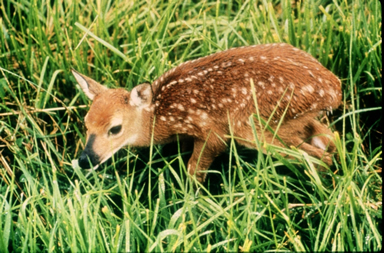
About
A subspecies of the common white-tailed deer, the Columbian white-tailed deer is found along the Columbia River in Clatsop and Columbia Counties and Wahkiakum and Cowlitz Counties in Washington, and in the Umpqua River basin in Douglas County. It is the westernmost subspecies of white-tailed deer in North America, which has a range that stretches across most of North, South and Central America, and can be distinguished from other subspecies by its large size. Columbian white-tailed deer feed on young willow, cottonwood, alder and other deciduous trees in the riparian areas (riverbanks and surrounding land) where they spend most of their time. These riverside thickets also offer protection from the deer’s predators. Male Columbian white-tailed deer are much larger than females, and sport an impressive pair of antlers that they shed each winter and regain in early spring. Both sexes have a white underside to their tails, which gives the deer its name.
- Find out more about Oregon Wild's work protecting the riparian ecosystems these deer need to survive!
Why does it need our help?
The Columbian white-tailed deer was once abundant throughout the Willamette, Columbia and Umpqua River valleys and north to Puget Sound in Washington. Historic records indicate that the subspecies once numbered in the tens of thousands, but by the time of their listing in 1968, their population had dropped to under 1,000. This was largely due to agricultural and logging activities, as well as development for homes and commercial areas that disrupted the riparian ecosystems these deer depend upon. Adding to their decline, there were no restrictions on the hunting of this subspecies until they were listed as endangered. The Douglas County population was recently delisted, as its numbers have rebounded to nearly 6,000, though the subspecies as a whole is still listed as threatened on the Endangered Species List. In order to maintain this upward trend in population growth and ensure a meaningful recovery of this animal it is extremely important to protect sensitive river ecosystems, and to make sure there is enough suitable habitat to support current and future populations of Columbian white-tailed deer.
- Want regular news on our efforts to protect Oregon's imperiled wildlife, and what you can do to help? Sign up for our monthly Wolves and Wildlife Newsletter!
Did you know?
- Around 1 in 10,000 female Columbian white-tailed deer will have antlers.
- The white underside of these deer's tails is generally only visible when they raise their tails when they sense danger.
- Columbian white-tailed deer can reach speeds of 36 miles per hour, and leap as far as 30 feet, and 8 1/2 feet high.

